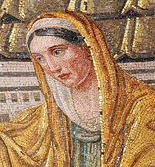Santa Pudenziana
| Santa Pudenziana | |
|---|---|
| Basilica of Saint Pudentiana | |
Basilica di Santa Pudenziana | |
Paleochristian, Romanesque | |
| Completed | 1588 |
| Administration | |
| Diocese | Rome |
Santa Pudenziana is a church of Rome, a basilica built in the 4th century and dedicated to Saint Pudentiana, sister of Praxedes and daughter of Pudens (mentioned by Paul the Apostle in 2 Timothy, 4: 21). It is one of the national churches in Rome, associated with Filipinos.
The authenticity of Pudentiana has been questioned and the name suggested to have originated in an adjective used to describe the house of Pudens, the Domus Pudentiana.[citation needed]
History

The Basilica of Santa Pudenziana is recognized as the oldest place of Christian worship in
The basilica is situated below the modern street level. Entrance is through wrought-iron gates. Steps that were added in the 19th century descend to a square courtyard from both sides of the entrance. The architrave of the entrance hall of the faded façade (1870) has a marble frieze that used to belong to a portal of the 11th century. It is a significant work of medieval sculpture in Rome. From left to right it depicts Pastore, the first owner of the basilica; Pudentiana; Praxedes; and their father, Pudens. The columns in the nave were part of the original edifice.
The Romanesque belltower was added in the early 13th century. Restorations of 1388 by Francesco da Volterra, pursuant to order of Cardinal Enrico Caetani, Camerlengo of the Holy Roman Church, transformed the three naves into one and a dome was added that Francesco da Volterra also designed. The painting of Angels and Saints before the Savior in the interior of the dome is a fresco by Pomarancio. During these last restorations some fragments of a Laocoön group were found that were larger than those in the Vatican City. Because none was willing to pay extra for this find, the hole in the ground was filled. These fragments were never recovered. The façade was renewed in 1870 and Pietro Gagliardi added frescoes.
The right side of the basilica was part of a Roman thermae, i. e. bath house, dating to the reign of the emperor Hadrian (AD 117–38).
Interior
On the wall behind the high altar are three paintings made in 1803 by Bernardino Nocchi representing (from left to right): St Timotheus, The Glory of St Pudentiana, and St Novatus.
The
This mosaic is remarkable for its
One scholar has suggested that the enthroned figure in the center of the apse mosaic normally regarded as Christ, in fact represents God the Father,[3] which would be an extremely unusual depiction of God the Father in art at this date.
Chapels

- The Peter chapel, on the left side of the apse, contains a part of the table at which cortile with a small chapel that contains frescoesfrom the 11th century.
- Chapel of the Crucifix: contains a bronze crucifix by Achille Tamburini.
- Chapel of the Madonna of Mercy: contains the painting The Nativity of the Madonna by Lazarro Baldi
- Chapel of St. Bernard: contains a painting of St Benedict and St Catherine of Siena
- Caetani chapel: This chapel for Caetani family (family of Pope Lumachella marble. The relief (1599) above the altar is by Pier Paolo Olivieri and depicts Adoration of the Magi. Giovanni Paolo Rossetti painted St Praxedes and Pudenziana collecting the Blood of the Martyrs in 1621. He also painted the fresco of the Evangelist in the ceiling, to a design by Federico Zuccari.
The statue of Saint Pudentiana (c. 1650) in a niche is by Claude Adam. The sisters’ well stands just outside the Caetani chapel in the left aisle, which is said to contain the relics of 3,000 early martyrs, many of which were brought here and hidden by Pudentiana and Praxedes. This is marked by a square porphyry slab in the floor.
Following the decline of popular piety ushered by the ecclesiastical reforms of the Second Vatican Council in 1969, the names of Pudentiana and her sister Praxedes were removed from the General Roman Calendar.
Titular church
The church serves as a
See also
- Filipinos in Italy
References
Bibliography
- "Santa Pudenziana", katolsk.no.
- Fredric W. Schlatter, The Text in the Mosaic of Santa Pudenziana, Vigiliae Christianae, Vol. 43, No. 2 (Jun., 1989), pp. 155–165
- Review by W. Eugene Kleinbauer of The Clash of Gods: A Reinterpretation of Early Christian Art, by Thomas F. Mathews, Speculum, Vol. 70, No. 4 (Oct., 1995), pp. 937–941, Medieval Academy of America, JSTOR
- (in Italian) Antonietta Cozzi Beccarini, "La cappella Caetani nella basilica di Santa Pudenziana in Roma", Quaderni dell'Istituto di Storia dell'Architettura, 22, 1975, pp. 143–158
- Matilda Webb, The churches and catacombs of early Christian Rome: a comprehensive guide, Sussex Academic Press (February 2002), ISBN 1-902210-58-1
External links
- Kunsthistorie.com Archived 2012-07-16 at the Wayback Machine, photogallery.
- Santa Pudenziana Mosaics and Roman Origins Archived 2017-08-10 at the Wayback Machine
![]() Media related to Santa Pudenziana at Wikimedia Commons
Media related to Santa Pudenziana at Wikimedia Commons
| Preceded by Santa Prassede |
Landmarks of Rome Santa Pudenziana |
Succeeded by Santi Quattro Coronati |
